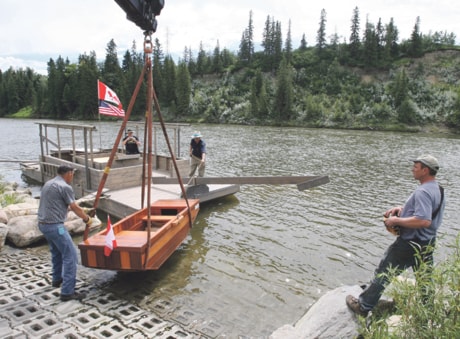The expectations Darren Tanke built up over the past eight years drowned just nine days after he and a crew embarked on scow boat expedition along the Red Deer River.
Tanke, a paleontology technician with 31 years experience at the Royal Tyrrell Museum, spent most of the past decade preparing for this personal quest to celebrate the 100th anniversary of the first major dinosaur-hunting voyage on the Central Alberta waterway.
He aspired to follow the original route and even built a full-scale replica of the boat that Barnum Brown and his team from the American Museum of Natural History used to explore the area in 1910.
The first of many problems arose for the latest group when one of the tillers was smashed after the boat hit a bridge piling a couple of kilometres after launching the scow at the boat launch near Bower Ponds on June 29.
Despite being able to repair the tiller, numerous other issues arose and forced Tanke to end the tour just over a week after embarking on the adventure that was originally to last for five weeks.
“I had just poured all my energies into the project, so when the project actually happened I was pretty exhausted,” Tanke said this week from his home in Drumheller where he is still recuperating.
“And then when we started to have logistical and technical issues, they were just a bit overwhelming for me.”
The crew, which consisted of eight people, had to act quickly before a leaning tree nearly swiped the tent that sat perched on the flat-bottomed boat.
Inexperienced at steering the scow, they also wound up grounded a few times.
A thunderstorm proved the tent was not as waterproof as it was sold to be.
A crew member fell and gashed her hand on, ironically, a box of safety equipment. She received stitches at the Red Deer Regional Hospital Centre before they carried on.
The scow got stuck on rocks numerous time during the journey, including six times in one day. This is something that still leaves Tanke bewildered as he said such a problem was never recorded in the historic field notes.
Still, rocks proved to plague the modern crew, so much so that the scow was lifted out of the water some 12 km from the launching point.
The vessel was then transported to Content Bridge, where Hwy 21 crosses with the Red Deer River, and they carried on from there.
The venture was officially called off, however, after Tanke fell ill.
He collapsed while on land at Dry Island Buffalo Jump Provincial Park on July 4 as he tried to find a spot to update the blog on which he recorded the journey.
Tanke was taken to the Three Hills Health Centre by ambulance and it was discovered he was anemic, suffering from low potassium levels and low hemoglobin.
A support crew quickly took over the scow at that point and they arrived back in Drumheller on July 7.
The team never had the opportunity to search for dinosaur fossils as they originally intended and the scow since been put in storage.
“It makes me wonder what these guys were enduring, logistically wise and emotionally wise,” Tanke said of the previous explorers. “It gives you a whole new respect and admiration for the work that these early collectors did.”
But the adventure wasn’t a total writeoff, he noted.
Tanke said, thankfully, members of the public were always near when the crew found themselves in trouble.
Kayakers and fishermen helped free the scow from the rocks while a group of hikers were close by when Tanke collapsed.
Despite cutting their tour short, Tanke said the 2010 scow travelled further downstream than the original explorers, who abandoned ship in 1912 at Morrin Bridge, some 39 km from Dry Island Buffalo Jump Provincial Park.
His tour was also the first scow-based expedition on the Red Deer River since 1916.
But perhaps the greatest of all the achievements, Tanke said, are the lessons they learned the hard way, which he hopes will result in smoother sailing for the tour he plans next summer.
“There are some major achievements but certainly not quite how we planned things, but I guess that’s what adventures are about sometimes,” he said.
“There was a lot of time and effort invested and certainly things didn’t work out as I had planned, but I think we can try again next year that much wiser and that much more prepared to make it work.”
Some adjustments that may be made for the redemption journey include adding galvanized steel to the bottom of the nine-metre-long, four-metre-wide shallow draft boat and travelling with an accompanying motor-powered boat, both of which could aid in getting off rocks.
“We can lick our wounds and try again next year,” Tanke said.
“The Red Deer River has not seen the last of me and that scow.”
ptrotter@www.reddeeradvocate.com
